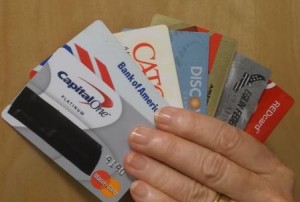by Elaine Courtney | Sep 4, 2013

Credit card debt is something that hangs over many Americans. According to the Federal Reserve, in April 2013, the average credit card debt equaled $3,364 per U.S. adult. This assumes that EVERY adult has a credit card and that those cards carry debt. Of course, not all adults own a credit card. Young Americans are among those ditching their credit cards.
The only way to reduce credit card debt is to make payments each month and not add to that debt. The main way to reduce this even faster is to pay more than the minimum payment each month.
Save Nearly $4,000 by Paying More than the Minimum Balance
By only paying the minimum monthly balance, you are guaranteed to pay this debt for a longer time and pay more in total cost. For example:
|
Total Credit Card Debt
|
Monthly Payment
|
Years to Pay Off
|
Total Cost
|
|
$3,364 (at 14.96% Interest)
|
$67.28 (min. payment)
|
19 Years 5 Months
|
$7,618.63
|
|
$3,364 (at 14.96% Interest)
|
$87.28 (min. payment +$20)
|
4 Years 4 Months
|
$4,533.67
|
|
$3,364 (at 14.96% Interest)
|
$107.28 (minimum payment +$40)
|
3 Years 4 Months
|
$4,225.11
|
|
$3,364 (at 14.96% Interest)
|
$167.28 (minimum payment +$100)
|
1 Year 1 Month
|
$3,841.40
|
Similar information is available on your monthly credit card statement. It will identify how long it will take you to pay your debt if you only pay the minimum or if you pay a little extra. More info on how to read your bill is found at: http://www.federalreserve.gov/creditcard/flash/readingyourbill.pdf
You also can use an online calculator to determine costs and payoff information.
http://www.federalreserve.gov/creditcardcalculator/
Want to avoid the minimum payment trap completely? Follow these tips from financial experts:
- Know What You Owe – Make a list of all outstanding debt balances with the names of creditors, monthly payments, and APRs (interest rates).
- Run the Numbers – Use the Minimum Payment Calculator http://www.federalreserve.gov/creditcardcalculator/ and calculate the cost of making minimum and larger payments on various amounts of debt.
- Use a “power payment” to pay off your debt. Visit http://powerpay.org/
- Read the Numbers – Check your credit card statements about the cost of making minimum payments.
- Pay Cash – Instead of making new purchases with a credit card and adding them to outstanding balances, save up and pay cash (or use a debit card) to avoid interest charges.
- Set a Goal – To know how much to save, set a target date and dollar amount and work backwards. For example, $3,000 for a big screen television in a year requires weekly savings of about $58 ($3,000 ÷ 52).
In the example above, finding an extra $100 a month to apply to credit card payments reduces the time it will take you to pay off this debt from over 19 years to just over one year AND saves you nearly $4,000.
Need help finding ways to save? Take the Florida Saves pledge to make a commitment to yourself to save and to receive emails and/or text messages to keep you motivated.
Contact your local UF/IFAS County Extension office to find more ways and resources to help you manage your money. Be sure to join us for the Women & Money Program Oct. 1, 8, & 15!
by Elaine Courtney | Apr 24, 2013
 Have you ever been in this situation? You are with friends and they suggest going somewhere for dinner. Your finances are tight and you really can’t afford to eat out at the pricey place suggested. What would you do?
Have you ever been in this situation? You are with friends and they suggest going somewhere for dinner. Your finances are tight and you really can’t afford to eat out at the pricey place suggested. What would you do?
1. Admit you don’t have the funds and say, “I really can’t afford it.”
2. Keep quiet and go along—you’ll just order an appetizer and water.
3. You enjoy being with friends so go ahead and buy what you want!
Saying those words, “I can’t afford it,” is something many have struggled with at one time or another. Some may feel shame or embarrassment if they utter those words. But there’s nothing wrong with saying it! Money issues are often difficult to discuss or verbalize. Perhaps rephrasing it would help– “That’s out of my price range right now.”
It is important to be honest with yourself about what you can afford. Facing reality may be difficult but it can reduce your financial stress. Would you rather confront things now or when you are struggling to pay your credit card bill? However, do you even know if you can afford it?
Everybody needs to learn how to manage money. Good money management includes being able to pay your monthly bills, save for the future, and buy the things you need and want without creating unmanageable debt. A spending plan can be a helpful money management tool. For resources on spending plans and more, click here.
You probably have noticed that different people have different attitudes about money. Some people want to collect as much as they can, while others want to buy as many goods and services as they can. Recognizing your attitude about money can help you deal with situations where you say, “I can’t afford it.”
Recent articles by Jean Chatzky and the Wall Street Journal discussed having to admit when you can’t afford something.
Here are some tips for saying “I can’t afford it:”
• Know your situation and what you will say when presented with an offer: “Let me check my budget/spending plan.” “Let me think about that.” “That’s not in my plan for today. Maybe another time.”
• Understand the emotions that are involved. Friends often get their feelings hurt if you never want to go with them. Explaining your plans in advance can often help you avoid misunderstandings.
• Peer pressure encourages us to spend money when we can’t afford it. The constant barrage of advertisements or friends, family, or co-workers can exert pressure to part with your money. When you have a clear understanding of your money and financial goals, it may make it easier to resist. But it is not always easy!
Knowing and understanding your finances will help you find the courage to say, “I can’t afford it” or “That’s out of my price range.”
by Elaine Courtney | Feb 18, 2013
Saving money can be easy or it can be extremely difficult. Why should you save? To set aside money you could spend today…so you can spend it tomorrow! Ask yourself some hard questions:
What would happen if…
- You lost your job?
- You got sick?
- You had an emergency?
How will you pay for big purchases? Will you be able to retire?
 What makes the difference? Understanding the Keys to Successful Savings! The theme for Saves Week focuses on these three key components of savings: Set a Goal, Make a Plan, Save Automatically.
What makes the difference? Understanding the Keys to Successful Savings! The theme for Saves Week focuses on these three key components of savings: Set a Goal, Make a Plan, Save Automatically.
Today let’s focus on the first part of Successful Saving–Set a Goal.
What do you want? Are you searching for ways to save money to pay off late bills or keep up with this month? Do you need to go to the dentist, buy or fix things for your home and family, pay for day care, or train for a better job? Do you want to buy a bicycle for your kids and/or send them to college? Without clear goals, you don’t know where you’re going.
Financial goals identify what you want to do with your money. Goals give you direction. They give you a purpose for the way you spend your money
 What constitutes a goal? A statement such as “I want to save money” is too vague. It becomes a realistic financial goal by adding a dollar amount, and a time frame. For instance, “I want to save $25 a week for 12 months”. An actual goal, however, would depend on an individual’s or family’s income and values.
What constitutes a goal? A statement such as “I want to save money” is too vague. It becomes a realistic financial goal by adding a dollar amount, and a time frame. For instance, “I want to save $25 a week for 12 months”. An actual goal, however, would depend on an individual’s or family’s income and values.
Make your goals SMART! Creating SMART goals gives us an action plan for reaching the goals we set.
Specific -Write down exactly what it is you want to accomplish. For example, instead of writing “I want to pay off credit card debt,” write, “I want to pay off the $5000 balance on my Visa Card.” Instead of writing, “I want to start an emergency fund,” write, “I want to save $1000 in an emergency fund.
Measurable –Financial goals are measured by a dollar amount, and you want to be able to see the progress you are making toward your goal. In the example we used before, if I want to pay off $5000 in credit card debt, I need to figure out how much money I need to pay per month, based on my deadline (this is the Time-Bound part- we’ll get to it shortly). If I wanted to pay it off in 12 months, I would need to pay around $420 per month (plus a little extra to cover interest and fees). Each month, I will see measurable progress toward my goal as my balance decreases.
Adaptable –With finances, we always need to be adaptable. Things change, life happens, emergencies come up, and we have to change our plans. Make sure that your goals are adaptable for changes in your financial situation. For instance, if you figure out that you want to pay $300 per month toward paying down your credit card debt, but then you have some unexpected expenses one month, you may have to pay less this month and either make up for it next month or stretch out your timeline.
Realistic –One of the biggest reasons we do not reach our financial goals is because we set the bar too high. If I only have $100 extra dollars in my budget, but I commit to paying $300 toward my credit card bill, I am setting myself up for failure. I could make this goal more realistic by 1) lowering the amount I plan to pay toward my credit card bill and stretching out the time I will be paying it down or 2) looking for other places in my budget where I can cut expenses in order to make this payment possible.
Time-Bound –Set deadlines for your financial goals! If you are anything like me, tasks without deadlines get pushed farther and farther down my to-do list. If you are serious about meeting your financial goals, set deadlines by which you want to accomplish them. This will also help you to determine how to measure your goals (see making your goals measurable above.
The second key to successful savings is to MAKE A PLAN. No matter what your financial goals are, it is important to map out a plan for achieving success.
The final key is to SAVE AUTOMATICALLY. Have part of your paycheck deposited into savings or transferred from checking to savings. You can also participate in retirement accounts that have automatic deposits made each pay period. This makes it easy to save and removes the temptation of having that money easily accessible.
As part of SAVES WEEK, there will be an on-line presentation and discussion about the Keys to Successful Saving on Tuesday, February 26, 11:30-12:30 CST. This might be just the motivation you need to get started saving!
February 26
3 Keys to Successful Savings –Create SMART goals, find money to save, make a savings plan, and choose the right savings accounts to reach your goals. http://bit.ly/3KeySaves. Participating is easy and free! We will send you a reminder email and the login instructions! Hope you’ll join me!
Don’t forget to join other savers…Become an Okaloosa Saver http://bit.ly/Al9BuH or Florida Saver at http://fycs.ifas.ufl.edu/Extension/FinancialManagement/FloridaSaves/Florida_Saves_Enrollment_Form.pdf.
Additional webinars will be held during Saves Week (all times are 11:30-12:30 CST):
February 27
Goal – Based Investing – Learn how to use a goal-based investment strategy to achieve financial goals. Learn to effectively develop a financial plan and choose investment accounts that work for particular goals. http://bit.ly/UFINVest
February 28
Tips for Tax Preparation & Filing – Review options for free tax filing, tax credits & tax deductions. Tips to analyze returns to help with financial decisions. http://bit.ly/TaxFil
Prepared by: Elaine A. Courtney
Family & Consumer Sciences Extension Agent
UF/IFAS Extension-Okaloosa County
850-683-8431
ecourtne@ufl.edu
by Elaine Courtney | Feb 18, 2013
 Setting a goal is the first step in taking charge of your finances. However, staying on track to meet that goal can be hard! The America Saves Challenge will help you meet your goals by providing daily encouragement and challenge!
Setting a goal is the first step in taking charge of your finances. However, staying on track to meet that goal can be hard! The America Saves Challenge will help you meet your goals by providing daily encouragement and challenge!
The 2013 America Saves Challenge is part of America Saves Week (February 25-March 2, 2013), a time set aside annually to promote good savings behavior. The “2013 America Saves Challenge” is a free five-week program, held from Sunday, February 24, through Saturday, March 30, 2013. There will be weekly prizes and final challenge awards at the end of program.
You may enroll online at http://rutgers.ancc.net/ (Rutgers Cooperative Extension Small Steps to Health and Wealth™ Challenge Web site)
- Set up a user name and password and
- Download a one-page user’s guide with instructions about how to proceed.
- Enroll in the Challenge titled “2013 America Saves Challenge.” This challenge will be among a list of names of online challenges that are currently available.
When people track their behavior and measure how they are doing, they are often inspired to do better and achieve positive results. Participants in the America Saves Challenge are “on their honor” to report their activities accurately. If they “cheat” on reporting their points, they are only cheating themselves by not following the recommended financial practices.
The America Saves Challenge is based on the performance of ten recommended financial practices. Ten points are given for performing each one. (Maximum of 700 points per week) “The Challenge is a great way to convert personal financial goals, like saving money and learning about investing, into daily action steps,” notes Dr. Barbara O’Neill, Extension Specialist in Financial Resource Management for Rutgers.
Participants will receive daily motivational messages. Paper tracking forms are available to keep track of daily activities.
Doing even one of the ten recommended daily financial practices is a great way to get started on your financial goals. The more America Saves Challenge activities you do, the better your financial progress.
To participate in the America Saves Challenge, visit http://rutgers.ancc.net/, register an account, and enroll in the “2013 America Saves Challenge.”
For additional information, contact Elaine Courtney, University of Florida-IFAS/Okaloosa Extension @ 850-683-8431 or your local Cooperative Extension Office.
by Elaine Courtney | Apr 25, 2012
 Are you feeling the stress of rapidly increasing gas and food prices? Today is a good day to begin changing your financial situation! Start by learning about important money matters and taking steps to improve your money skills.
Are you feeling the stress of rapidly increasing gas and food prices? Today is a good day to begin changing your financial situation! Start by learning about important money matters and taking steps to improve your money skills.
These five steps will help you on your path to “financial wellness.”
- Make a commitment. Changing your relationship with money is not easy—it takes hard work and commitment. Set a financial goal, commit to it, and become an American Saver at http://americasaves.org . Also, visit http://financialliteracymonth.com for more resources.
- Assess your financial situation. Don’t hide your head in the sand. Truly look at your financial situation by completing a net worth statement. Your net worth is the value of all of your assets minus the total of all of your liabilities. Put another way, it is what you own minus what you owe. Knowing where you are today will help you determine the best path toward meeting your financial goals. For a net worth worksheet: http://bit.ly/hjfnQP
- Get Organized. Getting your financial house organized is a great way to begin on a clear path toward financial wellness. Visit Organize Your Financial Life or your local Extension office to receive a free copy of the “Money Management Calendar.”
- Set priorities. Understanding the difference between needs and wants will help you establish financial priorities and set realistic goals.
- Live on a Spending/Savings Plan (a.k.a.—“budget”). Spending less than you earn is easier said than done! A solid plan is the most important element for financial success.
Changing money management habits and your relationship with money can be hard work, but the payoff is priceless. Remember: stay flexible on your financial journey, revisit your plan, and make needed changes. Additional resources
Author: Elaine A. Courtney





